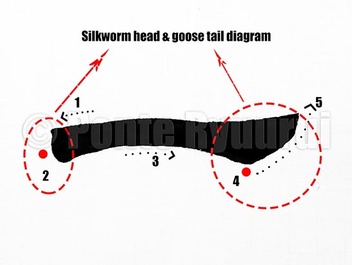 Clerical script (隷書) evolved from the great seal script (大篆). Its origins are dated back to the Warring States period (戰國時代, 475 – 221 B.C.E.) in China. There are two major types of clerical script. One is called ancient clerical (古隷), and the other is called mature clerical script (八分隷). The difference between those two, aside the various time periods throughout which they were used, is in writing technique, and , consequently, the appearance of both types of the clerical script. The technique shown in the picture (above) and the video (below) is applied in mature clerical script, however, it was initiated earlier on, and utilised for wring on long wooden slips (木簡). The name of this technique, the silkworm head and the goose tail (蠶頭雁尾), comes from the shape that those stroke resemble. Both techniques have many variants, and here you can see only one of them (the differences are in the appearance of both strokes, depending on the time period in calligraphy history, or the calligraphy style used for writing in the clerical script). Nevertheless, the technique of writing is always the same. In the above diagram you will notice numbers 1 - 5. They indicate the order of writing. Every stroke in clerical script begins with a reverse movement of the brush regardless of the direction of the stroke. This technique is known in Japanese calligraphy as gyakuhitsu (逆筆, lit. reverse brush),. One needs to crouch to make the leap graceful, as they say. This introduces a rhythm of writing which also slows down the brush in the process. The red dots (diagram) indicate where the brush should be stopped, briefly. All 5 movements ought to be completed in a single brush stroke (i.e. without lifting the brush tip off of the paper surface).
It is said, that mastering of this technique means that one has learned the basics of clerical script. It does not mean, however, that one has mastered the script itself. That comes with years and years of diligent practice. |
Categories
All
AuthorPonte Ryuurui (品天龍涙) Archives
August 2020
|

 RSS Feed
RSS Feed
